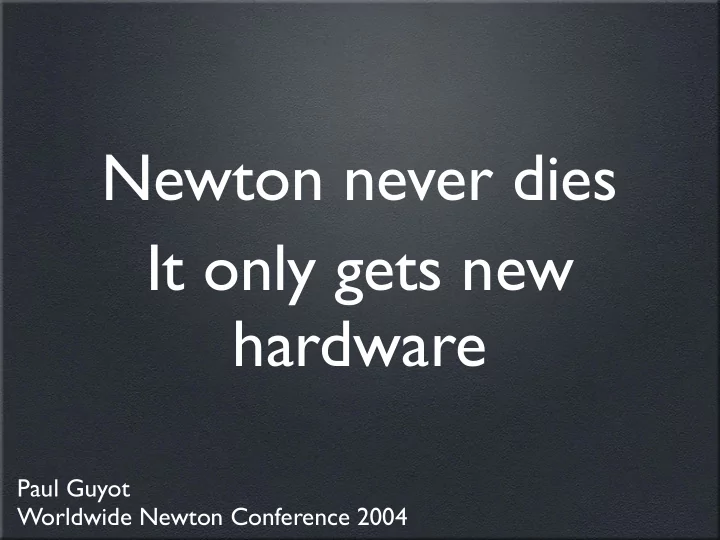

Newton never dies It only gets new hardware Paul Guyot Worldwide Newton Conference 2004
Introduction
Introduction (i) • Decreasing, limited supply of hardware • What is so great about the Newton cannot be found in other PDAs and Operating Systems : • Best industrial handwriting recognition • Data-centered • Newton Intelligence • Apple will not license NewtonOS to the community
Introduction (ii) • NewtonOS begins to be a little bit rusty for today’s uses and this is going to worsen: • No decent Java virtual machine • No CSS2 web browser and no cryptographic package (SSL/SSH) • Poor IPv4 (current version of Internet) and no IPv6 (next generation of Internet)
Introduction (iii) • In spite of huge efforts to keep the Newton up to date • WiFi driver with many supported 802.11b cards • Bluetooth drivers • Phone-like exchange capabilities (V-Cards...)
What kind of future?
“Let’s rewrite NewtonOS” • “Don’t you think we could rewrite a new operating system with all the good things of NewtonOS?” • Huge task (think about the cost of the Newton) • No immediate reward until the project is well advanced • It cannot be too close to the Newton because of Apple’s patents • No good handwriting recognition • NewtonScript is a key element of NewtonOS
GNUton (NewtonScript everywhere) • “The Newton is NewtonScript, let’s write a NewtonScript environment” • Since NewtonOS 2.0, less and less NewtonOS code is in NewtonScript. • NewtonScript only is for the interface and it only works on top of native code. • There is a huge amount of code to rewrite. • Many features such as the handwriting recognition are not written in NewtonScript.
The Einstein Project • 1- Write a Newton Emulator with all the hardware • 2- Port NewtonOS to ARM-powered PDAs • 3- Extend NewtonOS on this new hardware • Each small step is important for the platform
The architecture of the Newton (2.1 units)
The problem of the Voyager Chipset • “Perhaps one day, [Brian Parker (of Palm Emulator fame)] and Paul Guyot will team up and write the Newton emulator for the rest of us. Where oh where can we get the Voyager chipset instructions?” (Adam Tow, 2004) • Cirrus developed it with Apple and will not produce any or give us the specifications.
The complexity of an emulator • “A Newton emulator has to emulate not only the ARM CPU but all the specialized ARM MMU functions and the custom hardware for DMA, IR, Flash, display, etc, etc. Not a simple job. I would estimate (and I have 30 years experience in systems and software engineering) that this is at least 5 man years of effort; attempting it without the detailed hardware documentation for a Newton MP2000 would almost certainly fail.” (John Arkley, Apple Employee #88, 04/1999)
Is it pointless?
How Einstein Emulator works and how we will be able to port NewtonOS
The N2 Platform (2.1 units) • Apple meant to license the N2 platform (2.1 units) to third party hardware manufacturer • Schlumberger’s Watson has custom hardware • There is room for ROM Extensions (REXes) coming after Apple’s ROM. • Drivers for custom hardware • Patches • Packages
The P-Class mechanism (i) • NewtonOS is one of the first operating system written in an object oriented programming language (C++, not NewtonScript) • C++ lacks dynamism with interfaces and implementations being chosen at runtime. In other words, drivers cannot be written without some glue. • NewtonOS team defined P-Classes with drivers in a registry that can be replaced (overridden)
The P-Class mechanism (ii) • There is an interface called TStore for storage of objects on flash memory. • There are two implementations in NewtonOS: TPackageStore (for read-only stores in Newton packages) and TFlashStore (for internal memory and linear cards) • One can provide a new implementation called TATAStore for ATA cards • Same with, e.g., sound codecs (built-in: GSM, DTMF, provided by packages: MP3, Macintalk)
The P-Class mechanism (iii) • There is a P-Class interface for the platform driver and an implementation for the Voyager Chipset. Hence we do not need to know the exact Voyager specifications • There are P-Classes for other hardware elements : battery, screen, tablet, sound, etc.
What’s next?
Future of the Emulator itself • The emulator allowed/will allow us to : • Understand the boot problems of some units • Understand and fix the calibration problem • Improve and develop more easily programs that access to the bowels of the NewtonOS • Read flash cards directly on a laptop and exchange data more easily (maybe coupled with the DCL) • Work & test system patches without damaging any unit
Porting NewtonOS • The emulator allowed us to discover the basic hardware locations required to run NewtonOS (e.g. timers) and the specifications of the drivers (e.g. we know how to turn the backlight) • We could either • run the emulator (with JIT for a decent speed) on a PDA • or run NewtonOS natively with custom drivers and little modifications
My suggestion • The emulator solves the hardware problem. However, NewtonOS lacks up-to-date software for web browsing, cryptographic, modern networking. • We could put NewtonOS on top of Unix and take advantage of all the open source software running on Unix • We then could extend NewtonOS with hooks to allow applications to take advantage of this code
Conclusion
Conclusion • Einstein is a set of propositions for a community-run future for the platform. • These propositions have in common a migration to new hardware and no complete rewrite of NewtonOS. • The emulator is just the first step.
New post-Apple era?
Questions ? pguyot@kallisys.net http://www.kallisys.com/
Recommend
More recommend